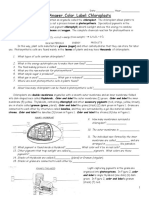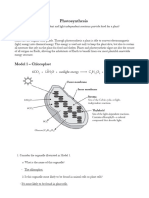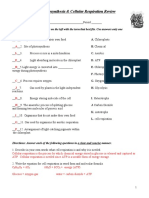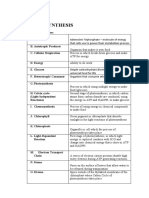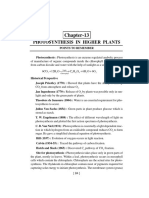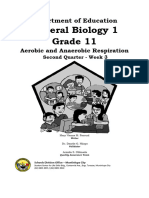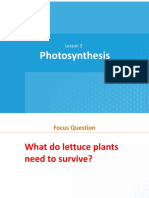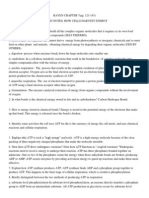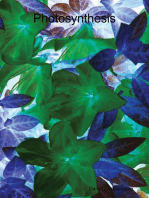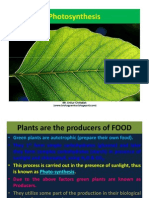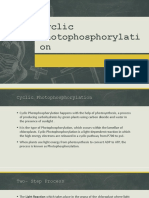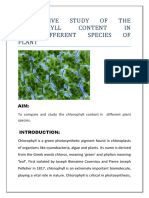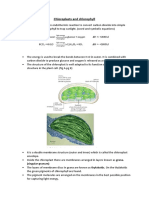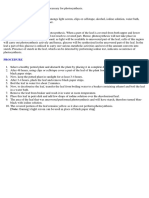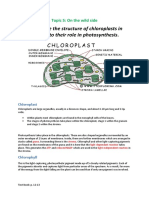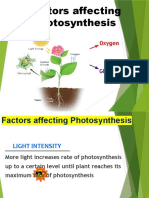0 ratings0% found this document useful (0 votes)
3K viewsAPBioCh10ReadingGuide10 11
APBioCh10ReadingGuide10 11
Uploaded by
Sergio LivingroomsThis document provides learning objectives and key concepts about photosynthesis. It discusses the process of photosynthesis including that it converts light energy to chemical energy by fixing carbon. It describes the two stages - the light reaction which produces ATP and the Calvin cycle. It explains the electron transport chain and chemiosmosis in chloroplasts, generating ATP from light energy. It also discusses alternative carbon fixation pathways plants use to minimize photorespiration.
Copyright:
Attribution Non-Commercial (BY-NC)
Available Formats
Download as DOC, PDF, TXT or read online from Scribd
APBioCh10ReadingGuide10 11
APBioCh10ReadingGuide10 11
Uploaded by
Sergio Livingrooms0 ratings0% found this document useful (0 votes)
3K views2 pagesThis document provides learning objectives and key concepts about photosynthesis. It discusses the process of photosynthesis including that it converts light energy to chemical energy by fixing carbon. It describes the two stages - the light reaction which produces ATP and the Calvin cycle. It explains the electron transport chain and chemiosmosis in chloroplasts, generating ATP from light energy. It also discusses alternative carbon fixation pathways plants use to minimize photorespiration.
Original Title
APBioCh10ReadingGuide10-11
Copyright
© Attribution Non-Commercial (BY-NC)
Available Formats
DOC, PDF, TXT or read online from Scribd
Share this document
Did you find this document useful?
Is this content inappropriate?
This document provides learning objectives and key concepts about photosynthesis. It discusses the process of photosynthesis including that it converts light energy to chemical energy by fixing carbon. It describes the two stages - the light reaction which produces ATP and the Calvin cycle. It explains the electron transport chain and chemiosmosis in chloroplasts, generating ATP from light energy. It also discusses alternative carbon fixation pathways plants use to minimize photorespiration.
Copyright:
Attribution Non-Commercial (BY-NC)
Available Formats
Download as DOC, PDF, TXT or read online from Scribd
Download as doc, pdf, or txt
0 ratings0% found this document useful (0 votes)
3K views2 pagesAPBioCh10ReadingGuide10 11
APBioCh10ReadingGuide10 11
Uploaded by
Sergio LivingroomsThis document provides learning objectives and key concepts about photosynthesis. It discusses the process of photosynthesis including that it converts light energy to chemical energy by fixing carbon. It describes the two stages - the light reaction which produces ATP and the Calvin cycle. It explains the electron transport chain and chemiosmosis in chloroplasts, generating ATP from light energy. It also discusses alternative carbon fixation pathways plants use to minimize photorespiration.
Copyright:
Attribution Non-Commercial (BY-NC)
Available Formats
Download as DOC, PDF, TXT or read online from Scribd
Download as doc, pdf, or txt
You are on page 1of 2
Sergio Salas
Name ________________________________________________________ Date _______________________
AP Biology Ch 10 - Guide Questions – Photosynthesis G. Toyos
Key concepts:
• photosynthesis is the way in which energy and carbon enter food webs
• conversion of light energy into chemical energy
• carbon fixation
• cyclic biochemical pathway
• electron transport chain and chemiosmosis
• evolutionary modifications to increase fitness
Learning objectives:
The Process that Feeds the Biosphere
1. Distinguish between autotrophic and heterotrophic nutrition.
a. An autotroph is an organism that can sustain itself and receive the required nutrients through its
own system; self feeders; produce organic molecules from CO2, these are producers, plants
i. Photoautotrophs or chemoautotrophs
b. A heterotroph is one that needs some outside source of nutrients; obtain organic molecules by
consuming others, known as consumers
2. Describe the structure of a chloroplast, listing all membranes and compartments.
a. 2 membranes enclosing a dense fluid calles stroma, in stroma there are thylakoid disks which
enclose a different fluid, some connected others alone, chlorophyll inside thylakoid space which
is where pigment is; stomata are pores to allow exchange
3. Write a summary equation for photosynthesis.
a. 6CO2 + 6H2O + Energy → C6H12O6 + 6O2
4. In general terms, explain the role of redox reactions in photosynthesis.
a. Reactants are 6CO2 and 12 H2O and products are C6H12O6 6H2O 6O2
b. Water is needed to provide electrons for the reaction
The Pathways of Photosynthesis
5. Describe the two main stages of photosynthesis in general terms.
a. Light phase – light is taken in and prepared for ATP synthesis
b. Calvin cycle – ATP produced
6. Explain how carotenoids protect the cell from damage by light.
a. Usually yellow or orange and absorbs those wavelength that chlorophyll cannot, and this helps
broaden then spectrum of light that can be taken.
7. List the wavelengths of light that are most effective for photosynthesis.
a. Chlorophyll absorbs red and violet-blue light while transmitting and reflecting green light
8. Explain what happens when a solution of chlorophyll a absorbs photons. Explain what happens when
chlorophyll a in an intact chloroplast absorbs photons.
a. Chlorophyll a absorbs photons and reacts by fluorescing in the red-orange part of the spectrum
and gives off heat
9. List the components of a photosystem and explain the function of each component.
a. A photosystem is a light capturing unit located in the thylakoid membrane of the choloroplast or
in the membrane of some prokaryotes, consisting of a reaction centar complex surrounded by
numerous light harvesting complexes. There is I and II
b. Reaction center complex is a bunch of proteins that associate with a chlorophyll molrculr to
trigger light reactions
____ Due 2/28
Sergio Salas
10. Trace the movement of electrons in linear electron flow. Trace the movement of electrons in cyclic
electron flow.
a. Linear flows from H2O to NADP+
b. Cyclic is in photosystem I
11. Explain the function(s) of linear electron flow. Explain the function(s) of cyclic electron flow.
a. Linear electron flow is a route of electron flow during the light reactions of photosynthesis that
involves photosystems I and II and produces ATP, NADPH, and O2.
b. Cyclic electron flow is a route of electron flow during the light reactions of photosynthesis that
involves only photosystem I and produced ATP but not NADPH or O2
12. Describe the similarities and differences in chemiosmosis between oxidative phosphorylation in
mitochondria and photophosphorylation in chloroplasts.
a. Chloroplasts and mitochondria both generate ATP by chemiosmosis. Some electron carriers such
as cytochromes are similar in chloroplasts and mitochondria. ATP synthase is also similar in
these two. In mitochondria, the high energy electrons dropped down the transport chain are
extracted from organic molecule, while in chloroplasts, this source of electrons is water.
Chloroplasts do not need food to make ATP. Mitochondria use chemiosmosis to transfer
chemical energy from food molecules to ATP, whereas chloroplasts transform light energy into
chemical energy in ATP
13. State the function of each of the three phases of the Calvin cycle.
a. Phase I: Carbon fixation. Here, each CO2 molecule is attached to five carbon sugar named
ribulose biphosphate, which is catalyzed by rubisco. The product is a 6 carvon intermediate that
will split in half to form 2 molecules of 3 phosphoglycerate (3GP)
b. Phase 2: Reduction. Each of those 3GP’s receives another phosphate group from ATP. Then, a
pair of electrons comes from NADPH reduces it to make G3P. It recycles the molecules after one
exits in order to regenerate 3 molecules of RuBP
c. Phase 3: regeneration of the CO2 acceptor RuBP. Carbon skeletons of 5 molecules of G3P are
rearranged by the last steps of the Calvin cycle into 3 molecules of RuBP. The cycle spends 3
more ATP and the RuBP is again prepared to receive CO2 and continue the cycle
14. Describe the role of ATP and NADPH in the Calvin cycle.
a. It needs 9 molecules of ATP and 6 of NADPH to produce one G3P molecule. Light reactions
regenerate these 2.
Alternative Mechanisms of Carbon Fixation
15. Describe what happens to rubisco when O2 concentration is much higher than CO2 concentration.
a. Rubisco can bind O2 in place of CO2 to the Calvin cycle. This entire process is called
photorespiration because it occurs in the light and consumes O2 while producing CO2.
16. Describe the major consequences of photorespiration. Explain why it is thought to be an evolutionary
relict.
a. It generates no ATP and no sugar. It decreases the photosynthetic output by siphoning organic
material from the Calvin cycle and releasing CO2 that would otherwise be fixed. It is
“evolutionary baggage” because long ago there was less O2 and more CO2 than today
17. Describe two important photosynthetic adaptations that minimize photorespiration.
a. C4 plants minimize the cost of photorespiration by incorporating CO2 into 4 carbon compounds
in mesophyll cells. This releases CO2 for the Calvin cycle. Also, CAM plants open their stomata
at night, incorporating CO2 into organic acids, which are also stored in mesophyll cells.
18. List the possible fates of photosynthetic products.
a. It is responsible for the presence of oxygen in our atmosphere. Carbohydrate, organic material,
respiratory fuel, sugars, cellulose and lots of other things.
____ Due 3/1
You might also like
- Photosynthesis Worksheet Version 2 SHORT 2018 KEYDocument4 pagesPhotosynthesis Worksheet Version 2 SHORT 2018 KEYDeonLeo Cuenca100% (1)
- Photosynthesis Worksheet Version 2 SHORT 2018 KEYDocument4 pagesPhotosynthesis Worksheet Version 2 SHORT 2018 KEYRosty Ann GrabilloNo ratings yet
- Worksheet Cellular Respiration#2 - Ch9 PDFDocument6 pagesWorksheet Cellular Respiration#2 - Ch9 PDFTaniaBarrios-ChongNo ratings yet
- Chapter 13 - Photosynthesis in Higher Plants PDFDocument8 pagesChapter 13 - Photosynthesis in Higher Plants PDFAdityaNo ratings yet
- Amoeba Sister Video CR and Photosynthesis QuestionsDocument2 pagesAmoeba Sister Video CR and Photosynthesis QuestionsKajal VaghasiaNo ratings yet
- .Beth Photosynthesis Coloring WorksheetDocument2 pages.Beth Photosynthesis Coloring WorksheetTes Say EamNo ratings yet
- AP Biology Exploration Guide - Cell Metabolism #3Document6 pagesAP Biology Exploration Guide - Cell Metabolism #3Gunnar OlsonNo ratings yet
- AP Biology Chapter 10 Notes - PhotosynthesisDocument5 pagesAP Biology Chapter 10 Notes - PhotosynthesisAustinNo ratings yet
- Mark Marlatt - Photosynthesis Pogil Track D - 5261224Document11 pagesMark Marlatt - Photosynthesis Pogil Track D - 5261224api-544304176No ratings yet
- Chapter 10Document3 pagesChapter 10cozmo0122No ratings yet
- Q2 STEM General Biology 1 Week 2Document4 pagesQ2 STEM General Biology 1 Week 2MarkElijah ObelNo ratings yet
- Unlock SGCh08Document8 pagesUnlock SGCh08SilaxNo ratings yet
- Photosynthesis POGIL answer keyDocument10 pagesPhotosynthesis POGIL answer keyAbby BartolataNo ratings yet
- Ap Bio Guided Reading Chapter 10 (Photosynthesis)Document4 pagesAp Bio Guided Reading Chapter 10 (Photosynthesis)nikisepanj83% (6)
- Chapter 8: Photosynthesis: Inquiry Into Life, Thirteenth EditionDocument2 pagesChapter 8: Photosynthesis: Inquiry Into Life, Thirteenth Editionmisst23No ratings yet
- Ch05 Answerkey Hoefnagels EssDocument7 pagesCh05 Answerkey Hoefnagels EssCry The WolffNo ratings yet
- Photosyntesis Worksheet 3Document5 pagesPhotosyntesis Worksheet 3Ryan De AlloNo ratings yet
- Chapter-4 Photosynthesis in Higher Plants: Very Short Answers QuestionsDocument10 pagesChapter-4 Photosynthesis in Higher Plants: Very Short Answers QuestionsPraveen KumarNo ratings yet
- Photosynthesis WorksheetDocument5 pagesPhotosynthesis WorksheetAshley JohnsNo ratings yet
- Photosynthesis & Cellular Respiration Review: K A L E BDocument7 pagesPhotosynthesis & Cellular Respiration Review: K A L E BDestiny DunkleyNo ratings yet
- Microbiology RevisionDocument27 pagesMicrobiology RevisionShevani KumarNo ratings yet
- Chapter 7 Reading Questions-1-1Document2 pagesChapter 7 Reading Questions-1-1Default AccountNo ratings yet
- Lecture 4 Carbohydrate-GlycolysisDocument20 pagesLecture 4 Carbohydrate-GlycolysisBiology BảoNo ratings yet
- PhotosynthesisDocument14 pagesPhotosynthesisValerie Duran-ArzagaNo ratings yet
- Chapter 7 Reading QuestionsDocument2 pagesChapter 7 Reading QuestionsDefault AccountNo ratings yet
- Ap Biology PhotosynthesisDocument7 pagesAp Biology PhotosynthesisMinh Triet LyNo ratings yet
- Photosynthesis (KEY)Document6 pagesPhotosynthesis (KEY)kylevNo ratings yet
- Light Dependent RXNDocument10 pagesLight Dependent RXNChristoPher TorioNo ratings yet
- Chapter 10 Multiple Choice Practice: CO H O O PDocument7 pagesChapter 10 Multiple Choice Practice: CO H O O PShaira CogollodoNo ratings yet
- Photosynthesis in Higher PlantsDocument8 pagesPhotosynthesis in Higher PlantsAditya VenkatNo ratings yet
- Energy TransformationDocument4 pagesEnergy TransformationAsh Nico BanquilloNo ratings yet
- Chapter-13: Photosynthesis in Higher PlantsDocument8 pagesChapter-13: Photosynthesis in Higher PlantssujushNo ratings yet
- APBio 10 NotesDocument5 pagesAPBio 10 Notes5377773No ratings yet
- AP Bio HW 9 091016Document5 pagesAP Bio HW 9 091016haithere123No ratings yet
- Photosynthesis Study GuideDocument9 pagesPhotosynthesis Study GuideJunhee KimNo ratings yet
- Activity10answers PDFDocument6 pagesActivity10answers PDFMuthu LakshmiNo ratings yet
- Topic I: Cell: The Basic Unit of LifeDocument70 pagesTopic I: Cell: The Basic Unit of LifeJai CataluñaNo ratings yet
- Photosynthesis Test ReviewDocument6 pagesPhotosynthesis Test ReviewFisherNo ratings yet
- Quarter 2 Module 1 General Biology 1 SCDocument31 pagesQuarter 2 Module 1 General Biology 1 SCAldrin James DafunNo ratings yet
- Science11 q2 Mod1 Generalbiology1-Aquino, Paul Reagan P.Document17 pagesScience11 q2 Mod1 Generalbiology1-Aquino, Paul Reagan P.Lyka Mae BenitoNo ratings yet
- The-Process-Of-Photosynthesis - SummaryDocument7 pagesThe-Process-Of-Photosynthesis - SummaryZaina SchoolNo ratings yet
- Activity 10 Answer KeyDocument8 pagesActivity 10 Answer KeyRyan LeeNo ratings yet
- Function of PhotosynthesisDocument58 pagesFunction of PhotosynthesisJulian ChristopherNo ratings yet
- PhotosynthesisDocument21 pagesPhotosynthesissujoysarkargurgaonNo ratings yet
- 11 Biology Notes ch13 Photosymthesis in Higher PlantsDocument6 pages11 Biology Notes ch13 Photosymthesis in Higher PlantsManan AhujaNo ratings yet
- AP M10 Ch9 Respiration Worksheet2Document5 pagesAP M10 Ch9 Respiration Worksheet2Jakie Ubina0% (1)
- Q2W3 General Biology ModuleDocument10 pagesQ2W3 General Biology ModuleBatman Of monstadtNo ratings yet
- Biology The Dynamic Science 4th Edition Russell Solutions Manual 1Document10 pagesBiology The Dynamic Science 4th Edition Russell Solutions Manual 1matthew100% (48)
- 27-Week#4-Bio-9-PPT SlidesDocument31 pages27-Week#4-Bio-9-PPT Slidesاحمد جمعهNo ratings yet
- 2nd Quarter - Gen. Bio.1Document38 pages2nd Quarter - Gen. Bio.1Reylyn SantiagoNo ratings yet
- UCSPDocument14 pagesUCSPbm5755768No ratings yet
- Unit 5. Revision Notes in Accordance With Syllabus SpecificationsDocument16 pagesUnit 5. Revision Notes in Accordance With Syllabus SpecificationsShoaib Ahmed SamNo ratings yet
- Light Reactions and The Calvin CycleDocument24 pagesLight Reactions and The Calvin CycleMay NisperosNo ratings yet
- LESSON 10 - PHOTOSYNTHESIS AND INTERNAL PARTS OF CHLOROPLASTSDocument6 pagesLESSON 10 - PHOTOSYNTHESIS AND INTERNAL PARTS OF CHLOROPLASTSMarion PootenNo ratings yet
- Ch. 7 Pre Reading QuestionsDocument8 pagesCh. 7 Pre Reading QuestionsDJ ISAACS25% (4)
- Photosynthesis: Study Guide Photosynthesis Equation: 6CO2 + 6H2O - C6H12O6 + 6O2Document4 pagesPhotosynthesis: Study Guide Photosynthesis Equation: 6CO2 + 6H2O - C6H12O6 + 6O2vscolegit shoppeNo ratings yet
- Photosynthesis in Higher Plants Imp QDocument12 pagesPhotosynthesis in Higher Plants Imp QssNo ratings yet
- Photosynthesis NotesDocument12 pagesPhotosynthesis NotesSulthan Ramiz100% (1)
- Photosynthesis WorksheetDocument4 pagesPhotosynthesis WorksheetJustin Marju De VeraNo ratings yet
- New Frontiers in Sciences, Engineering and the Arts: Volume Iii-B: the Chemistry of Initiation of Ringed, Ringed-Forming and Polymeric Monomers/CompoundsFrom EverandNew Frontiers in Sciences, Engineering and the Arts: Volume Iii-B: the Chemistry of Initiation of Ringed, Ringed-Forming and Polymeric Monomers/CompoundsNo ratings yet
- Tarea FotosíntesisDocument7 pagesTarea FotosíntesisAndy StevenNo ratings yet
- Chapter-2 Photosynthsis: Made By:zainah Jabr Grade:12-ADocument25 pagesChapter-2 Photosynthsis: Made By:zainah Jabr Grade:12-Azainah jabrNo ratings yet
- Photosynthesis in Higher PlantsDocument3 pagesPhotosynthesis in Higher Plantsparkash bharti public school prem nagar kirariNo ratings yet
- Gen Bio1 Module 9Document23 pagesGen Bio1 Module 9Anjhiene Camba100% (2)
- Chapter 6. PhotosynthesisDocument53 pagesChapter 6. Photosynthesisankurbiology100% (6)
- The Calvin CycleDocument11 pagesThe Calvin CycleYanni MerkhanelNo ratings yet
- Cyclic PhotophosphorylationDocument10 pagesCyclic PhotophosphorylationJenard Atos33% (3)
- Exer 10 PhotorespirationDocument17 pagesExer 10 PhotorespirationRochelle May Tabi100% (1)
- Cholorophyll Content in Five Different Species of PlantDocument14 pagesCholorophyll Content in Five Different Species of Plantlatest tamil moviesNo ratings yet
- Bioscience - Volume 1 No. 2 - Oktober 2017Document10 pagesBioscience - Volume 1 No. 2 - Oktober 2017A2-43 Muhammad Iqbal FathurrohmanNo ratings yet
- Algal Pigments PDFDocument5 pagesAlgal Pigments PDFmanoj_rkl_07No ratings yet
- Chloroplasts and Chlorophyll T5-3Document4 pagesChloroplasts and Chlorophyll T5-3Kyile FernandoNo ratings yet
- Light Is Necessary For Photosynthesis (Exp)Document10 pagesLight Is Necessary For Photosynthesis (Exp)Tanishq UppalNo ratings yet
- Photosynthesis - Simple English Wikipedia The Free EncyclopediaDocument3 pagesPhotosynthesis - Simple English Wikipedia The Free Encyclopediaapi-253604375No ratings yet
- Genbio1 ReviewerDocument3 pagesGenbio1 ReviewerStevenzel EstellaNo ratings yet
- 2do Parcial 4to B 2021Document3 pages2do Parcial 4to B 2021Sabrina Do CarmoNo ratings yet
- Topic 2: The Importance of Chlorophyll and Other Pigments: Light EnergyDocument5 pagesTopic 2: The Importance of Chlorophyll and Other Pigments: Light EnergyRaven BerzabalNo ratings yet
- Structure of A ChloroplastDocument2 pagesStructure of A ChloroplastsreenitthiNo ratings yet
- Bio 101 The LeafDocument80 pagesBio 101 The LeafLance CarandangNo ratings yet
- 11 Biology Notes Ch13 Photosymthesis in Higher PlantsDocument6 pages11 Biology Notes Ch13 Photosymthesis in Higher PlantsAAYUSH KUMARNo ratings yet
- 2.1. Factors Affecting PhotosynthesisDocument12 pages2.1. Factors Affecting PhotosynthesisGabriel Alejandro Garcia OrregoNo ratings yet
- Topic 4. C3, C4 and Cam Plant-PathwayDocument5 pagesTopic 4. C3, C4 and Cam Plant-PathwaySheryl Lou AngelesNo ratings yet
- WHLP Gen Bio 2 2nd QuarterDocument6 pagesWHLP Gen Bio 2 2nd QuarterSir JoshNo ratings yet
- Photosynthesis Classroom Notes FinalDocument97 pagesPhotosynthesis Classroom Notes FinalJACK SPARROWNo ratings yet
- Botany Lecture TransDocument22 pagesBotany Lecture TransAira Germaine TanganNo ratings yet
- Jurnal Hutan Lestari (2019) Vol. 7 (2) : 746 - 751Document6 pagesJurnal Hutan Lestari (2019) Vol. 7 (2) : 746 - 751Oswa PalullunganNo ratings yet
- Cellular Energy Resp PhotoDocument85 pagesCellular Energy Resp Photomuhra khaeld salim al abo aldariiNo ratings yet
- Photosynthesis_Cell+Respiration+Lab_revDocument5 pagesPhotosynthesis_Cell+Respiration+Lab_revliamooowasdadsNo ratings yet





